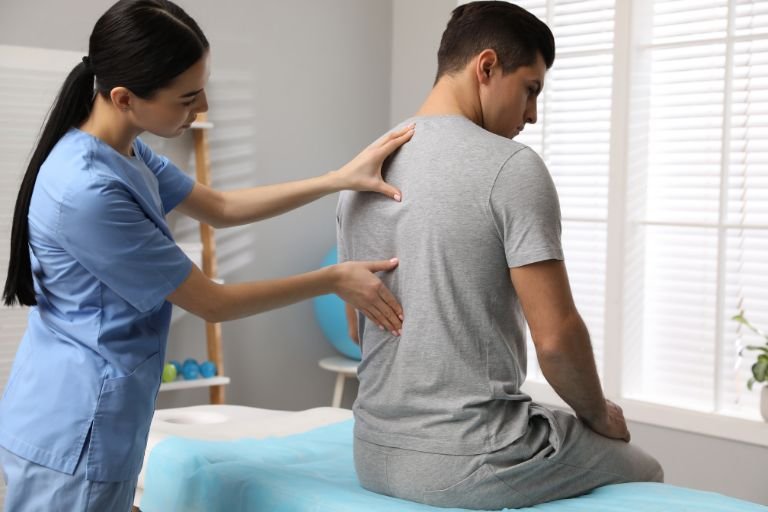- Fitwell Physiotherapy
Weakness & Paralysis

Weakness and paralysis are significant medical conditions that affect the muscles and their ability to function properly. Understanding their symptoms, causes, and management options is crucial for effective treatment and prevention.
Please submit your details below.
Symptoms
Weakness:
- Reduced muscle strength
- Fatigue
- Difficulty performing everyday tasks
- Unsteadiness or imbalance
Paralysis:
- Loss of muscle function in part of your body
- Numbness or tingling
- Loss of sensation in the affected area
- Muscle atrophy over time
- Possible difficulty in breathing, swallowing, or speaking (depending on the affected area)
Causes
Weakness:
- Muscular dystrophy
- Myasthenia gravis
- Chronic fatigue syndrome
- Electrolyte imbalances
- Neurological conditions such as multiple sclerosis
- Infections like influenza or Lyme disease
Paralysis:
- Stroke
- Spinal cord injury
- Multiple sclerosis
- Guillain-Barré syndrome
- Cerebral palsy
- Traumatic brain injury
- Neurodegenerative diseases such as ALS (Amyotrophic Lateral Sclerosis)
When to See a Physiotherapist
- Persistent or worsening muscle weakness
- Sudden onset of paralysis
- After a stroke or traumatic injury
- Difficulty in performing daily activities due to muscle weakness
- Post-surgical recovery where muscle strength and function are compromised
A physiotherapist can help with exercises and therapies to restore strength, improve mobility, and prevent complications.
Risks
- Weakness: Falls and injuries due to instability, reduced ability to perform daily tasks, and potential development of pressure sores from prolonged immobility.
- Paralysis: Increased risk of infections (e.g., urinary tract infections, pneumonia), pressure ulcers, blood clots, muscle atrophy, and depression due to loss of independence.
How to Prevent
- General Health: Maintain a healthy diet, regular exercise, and proper hydration.
- Avoiding Injuries: Use protective gear during sports and practice safety measures to prevent accidents.
- Chronic Conditions: Manage chronic conditions such as diabetes and hypertension to prevent complications that could lead to weakness or paralysis.
- Vaccinations: Keep up with vaccinations to prevent infections that can cause muscle weakness or paralysis (e.g., polio vaccine).
Treatments
Weakness:
- Physical Therapy: Exercises to improve muscle strength and endurance.
- Medications: Address underlying causes, such as antibiotics for infections or steroids for inflammatory conditions.
- Nutrition: Ensure adequate intake of essential nutrients and electrolytes.
- Assistive Devices: Canes, walkers, or braces to support mobility.
Paralysis:
- Physical and Occupational Therapy: Improve mobility and adapt to new ways of performing tasks.
- Surgery: In cases where structural issues like herniated discs are causing paralysis.
- Medications: Manage symptoms such as spasticity or pain.
- Assistive Technology: Wheelchairs, voice-activated devices, and other tools to improve independence.
- Rehabilitation Programs: Comprehensive programs that combine physical therapy, occupational therapy, and other treatments to maximize recovery and quality of life.
Conclusion
Weakness and paralysis are complex conditions that require timely medical intervention and ongoing management. Early detection, appropriate therapies, and preventive measures can significantly improve outcomes and quality of life for affected individuals.
Frequently Asked Questions
Recovery time can vary depending on factors such as the severity of the rupture, treatment approach, and individual healing capacity. Typically, recovery may take anywhere from 4 to 12 months. However, full return to pre-injury activities may take longer.
Treatment options include both surgical and non-surgical approaches. Non-surgical treatment may involve immobilization with a cast or walking boot, followed by physical therapy. Surgical repair may be recommended for younger, active individuals or severe ruptures, involving reattaching the torn tendon ends surgically.
Rehabilitation typically involves a progressive program focused on restoring strength, flexibility, and function of the affected leg. Initially, emphasis may be on protecting the healing tendon, followed by exercises to improve range of motion, strength, and eventually, functional activities such as walking and running.
While it’s not always possible to prevent all injuries, certain measures can reduce the risk of re-injury. These may include following a structured rehabilitation program, gradually returning to physical activities, wearing appropriate footwear, and incorporating exercises to strengthen the calf muscles and improve ankle stability.
Returning to sports or physical activities should be gradual and guided by your healthcare provider or physical therapist. Typically, athletes may start with low-impact activities such as swimming or cycling before progressing to higher-impact sports. The timing of return will depend on factors such as healing progress, strength, flexibility, and functional ability. It’s essential to avoid rushing the return to sports to minimize the risk of re-injury.
Related Symptoms
How Fitwell Physiotherapy Can Help?
Dr. Richa’s Fitwell physiotherapy has an extensive team of physiotherapists all within their own specialist areas of physiotherapy. Whatever your condition, we guarantee that we will have the best physiotherapist for you. We assess, diagnose, plan, cure and care for you.
Fitwell Physiotherapy Clinic, Pune provides you best physiotherapy treatment in Kharadi, pune. We also serve Chandan Nagar, Vadgaon Sheri, Keshav Nagar, Wagholi & nearby Areas in Pune. We are experts in treating Neck Pain, Hand Pain, Back Pain, Lower Back Pain, Knee Pain, Stiff Neck, Sciatica, Arthritis, Stroke Paralysis & Post Surgical Rehab.
We provide Specialized physiotherapy treatments in Sports Injuries, Pre and post Surgery, Neurologic, Pediatric, Chronic Pain/Fatigue, Rheumatology, Women’s Health, Men’s Health, Ergonomics, Vestibular, Amputees & all sort of Pain treatment and lifestyle conditions.
































